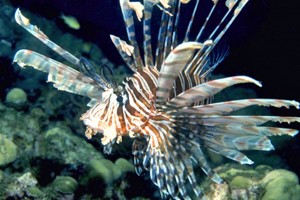The Invasion of the Lionfish
(Photo: Florida Sea Grant)
It is a song that has been played in our state time and again. An exotic pet or plant is brought across our borders and either intentionally or accidentally released into the environment. Tropical fish, exotic reptiles, and nonnative mammals escape and the next thing you know they are wandering the neighborhood.
In many cases these non-natives are just another part of the landscape but some species they become invasive and cause economic or environmental problems. There are many examples of invasives in Florida; iguanas, fire ants, Chinese tallow, Japanese climbing fern, and most recently – Burmese pythons. The states of Florida and Hawaii have the largest problems with these creatures thus they
have some of the toughest laws dealing with them; there is a $1000 fine for releasing in Florida. These creatures find plenty of food, few predators, and warm temperatures year round. It is no different in the Gulf of Mexico. Many tropical fish released into our waters do not survive the winters or the high salinities, but conditions are great for the lionfish.
The lionfish is from the western Pacific and range from Micronesia to the southern shores of Japan. They are cryptic and nocturnal in habit so detection difficult. They are found primarily on offshore reefs and feed on a variety of small fishes, shrimps, and crabs; they have few natural predators.
So how did they get here?
It is believed that the lionfish issue began with the aquarium trade. The most popular explanation for their release is the destruction of housing during the heavy hurricane seasons. The earliest record of a lionfish in Florida was in 1985 in the town of Dania. The first records in the northern Gulf were in 2010 when lionfish were seen in Apalachicola and Pensacola.
Are they invasive?
The answer is yes. These fish are voracious feeders consuming over 50 species of reef fishes, shrimps, crabs, and some accounts show them feeding on small spiny lobsters; many are economically important to us.
So what do we do about it?
The method of choice at the moment is removal by humans. Lionfish do not typically bite a hook so the most effective method is spearfishing. Many areas are hosting “Lionfish Rodeos” which reward divers for returning as many as possible. A rodeo held in Destin during the summer of 2012 landed 81 lionfish in a single day. On August 3, 2012 the state of Florida issued an executive order that will allow spear fishermen to capture lionfish without a saltwater license and no bag limit. This executive order will be effective for one year. Some communities consume lionfish and their flavor rating is good. However the FDA reported that lionfish live and feed on similar prey that many species of reef fish that develop ciguatera do. Though there have been no confirmed reports of ciguatera in lionfish there is a risk.
You can read more on this article at http://escambia.ifas.ufl.edu/marine/2012/08/17/the-invasion-of-the-lionfish or contact the Sea Grant agent at your local extension office.
- Tips for Bear Encounters this Fall - November 10, 2025
- Pensacola Bay Invasive Species Summer Survey 2025 - November 3, 2025
- Our Environment: Part 24 – Our Changing Climate - November 3, 2025

